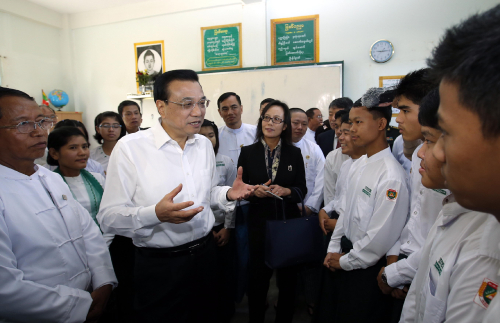 |
|
MEETING YOUTHS: Chinese Premier Li Keqiang talks with Myanmar students during a visit to a middle school in Nay Pyi Taw, capital of Myanmar, on November 14 (JU PENG) |
Ties with Myanmar
After the East Asian leaders' meetings in Nay Pyi Taw, Premier Li paid an official visit to Myanmar, with which China enjoys a paukphaw (fraternal) friendship. It was Li's first trip to Myanmar since he took office as Chinese premier last year.
During his trip, the two countries signed a deal to build power plants fueled by natural gas, one of a number of agreements worth $7.8 billion that touched on agriculture, telecommunications and finance cooperation. The two sides also agreed to establish an electricity cooperation committee as a working-level liaison channel for the energy sector, to keep projects on track.
Observers said that after some frustrating setbacks regarding Chinese investment in its infrastructure over the past few years, Myanmar is seeking to reassure investors from China that they are welcomed. In recent years, certain China-invested projects, such as the Myitsone hydropower plant in north Myanmar, were suspended by the Myanmar Government under the pretext of public will.
Ruan of the CIIS said that Premier Li's visit to Myanmar has further deepened mutual political trust, ushering in a new phase in China-Myanmar relations.
When meeting with Premier Li on November 14, Myanmar President U Thein Sein said that his country will support and actively participate in the Bangladesh-China-India-Myanmar Economic Corridor, the Silk Road Economic Belt, the 21st-Century Maritime Silk Road and the AIIB.
The president also promised to conduct cooperation with China in large-scale projects, increase people-to-people exchanges and promote bilateral ties to a new height.
Email us at: yulintao@bjreview.com
Proposals of Premier Li Keqiang at the 17th China-ASEAN Summit
First, working together to outline the grand strategy for further developing China-ASEAN relations, speeding up the drafting of the third Plan of Action to implement the joint declaration on the China-ASEAN Strategic Partnership for Peace and Prosperity (2016-20), and actively negotiating for a good-neighborly cooperation treaty between China and ASEAN countries.
Second, working together to upgrade the China-ASEAN free trade area and complete related negotiations before the end of 2015.
Third, working together to accelerate the building of a basic connectivity network, for which China will provide financial support to strengthen planning and building of telecommunication, electric power and Internet sectors, as well as improve the convenience of customs clearance, market supervision and standardization and regulation.
Fourth, strengthening the dialogue between China and ASEAN nations' maritime law enforcement organs, setting up a maritime cooperation center, implementing the Pan-Beibu Gulf Economic Cooperation Action Roadmap and projects under the China-ASEAN Maritime Cooperation Fund.
Fifth, working together to ensure both traditional and non-traditional security, to prepare for the China-ASEAN defense ministers' informal meeting next year, to explore possibilities of building a China-ASEAN defense hotline, conduct joint exercises, to deepen the law enforcement cooperation in the Mekong River Basin, and to carry out cooperation projects for disaster management.
Sixth, exploring new areas of cooperation in culture, people-to-people exchanges, science and technology and environment, speeding up the China-ASEAN cultural cooperation action plan, and strengthening cooperation in education, rural poverty reduction, public health personnel training, scientific research and environmental protection.
(Compiled by Beijing Review) | 